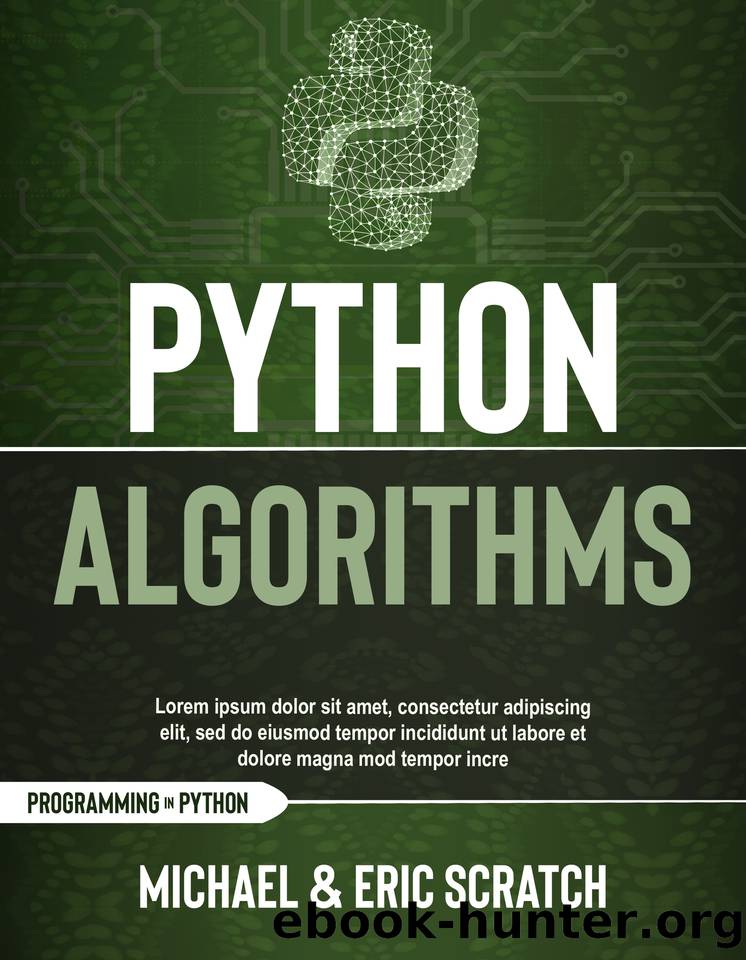PYTHON ALGORITHMS: A Complete Guide to Learn Python for Data Analysis, Machine Learning, and Coding from Scratch by Scratch Eric & Scratch Michael

Author:Scratch, Eric & Scratch, Michael [Scratch, Eric]
Language: eng
Format: epub
Published: 2020-12-11T00:00:00+00:00
Picking Out the Algorithms to Use
The first thing that we need to consider here is which of the different algorithms we are going to use. There are a number of algorithms that we are able to handle. And it is going to take some time to really ensure that we pick out the right one depending on the data that we want to work with and the types of information that we are working with when it comes to our data.
There are a lot of algorithms that we are able to handle, and they are going to fall under three main styles of machine learning, which is the idea that is going to really push and run our algorithms. These are going to include supervised learning, unsupervised learning, and reinforcement learning.
We are going to explore these in more detail in the next chapter. But we can take a moment to look through these here as well. To start with, we have supervised learning. This is where we are going to show a lot of examples to the algorithm with the right answers to the end. This helps the program to learn from these examples. Then we are able to test it on the knowledge it learns as we go through this process.
Then it is time to work with unsupervised learning. This one is a bit different because we are not going to show the algorithm the results with the example that we use. We expect the program to be able to learn all on its own. Instead, we are going to take the time to have the program learn on its own. This takes a bit more time for the program to learn and gain the right accuracy that we want. But when it gets to this point, you will find that the unsupervised learning is going to be really strong and can take on a lot more options and program capabilities than we will be able to go with all of the other choices. And then we can move on to reinforcement learning. This one is going to take us to another level as well, though, in the beginning, it is going to look like it is pretty much the same as the unsupervised learning that we were talking about above. The main difference that we are going to see with this one is that we will set this up in more of a trial and error kind of method. Reinforcement learning is going to work on trial and error and will be able to learn when it does things wrong or gets the wrong answer. It will remember all of this and work from there in order to get more accuracy. It learns on its own but has a set of rewards and punishments to help reinforce the kind of learning that we are trying to work with.
All of these can be important in helping us to handle some of the different things that we want to do with our data analysis.
Download
This site does not store any files on its server. We only index and link to content provided by other sites. Please contact the content providers to delete copyright contents if any and email us, we'll remove relevant links or contents immediately.
The Mikado Method by Ola Ellnestam Daniel Brolund(20717)
Hello! Python by Anthony Briggs(20005)
Secrets of the JavaScript Ninja by John Resig Bear Bibeault(18326)
Dependency Injection in .NET by Mark Seemann(18204)
The Well-Grounded Java Developer by Benjamin J. Evans Martijn Verburg(17681)
OCA Java SE 8 Programmer I Certification Guide by Mala Gupta(17493)
Kotlin in Action by Dmitry Jemerov(17302)
Adobe Camera Raw For Digital Photographers Only by Rob Sheppard(16937)
Algorithms of the Intelligent Web by Haralambos Marmanis;Dmitry Babenko(16317)
Grails in Action by Glen Smith Peter Ledbrook(15465)
Sass and Compass in Action by Wynn Netherland Nathan Weizenbaum Chris Eppstein Brandon Mathis(13326)
Secrets of the JavaScript Ninja by John Resig & Bear Bibeault(11432)
A Developer's Guide to Building Resilient Cloud Applications with Azure by Hamida Rebai Trabelsi(10582)
Test-Driven iOS Development with Swift 4 by Dominik Hauser(10416)
Jquery UI in Action : Master the concepts Of Jquery UI: A Step By Step Approach by ANMOL GOYAL(9440)
Hit Refresh by Satya Nadella(9085)
The Kubernetes Operator Framework Book by Michael Dame(8523)
Exploring Deepfakes by Bryan Lyon and Matt Tora(8348)
Robo-Advisor with Python by Aki Ranin(8295)
